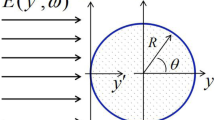Abstract
Ring modes with large wave vectors cannot be easily excited on a single disk by the plane wave illumination with the polarization parallel to the disk interface. In this work, we show that special antisymmetric ring gap modes on the surface of the disk in close proximity to the metallic thin film can be excited in the visible light region of the electromagnetic spectrum. In the presence of the film, the strong plasmon interaction between disk and film causes ring gap modes to have lower energies and be more easily excited. We apply the plasmon hybridization method to illustrate the ring gap modes arising from the interaction between the localized disk plasmons and the continuum surface plasmons. The calculated hybridization data show good agreement with the results of finite element simulations. The excitation of ring gap modes provides further insight into the strong coupling of plasmons and the design of novel nanostructures.





Similar content being viewed by others
Availability of Data and Material
The data and material that support the findings of this study are available from the corresponding author upon reasonable request.
Code availability
The codes generated during the current study are available from the corresponding author on reasonable request.
References
Zhang S, Wei H, Bao K, Hakanson U, Halas NJ, Nordlander P, Xu H (2011) Chiral surface plasmon polaritons on metallic nanowires. Phys Rev Lett 107:096801
Chang DE, Sørensen AS, Hemmer PR, Lukin MD (2007) Strong coupling of single emitters to surface plasmons. Phys Rev B 76:035420
Fang YR, Li ZP, Huang YZ, Zhang SP, Nordlander P, Halas NJ, Xu HX (2010) Branched silver nanowires as controllable plasmon routers. Nano Lett 10:1950–1954
Hao F, Nordlander P (2006) Plasmonic coupling between a metallic nanosphere and a thin metallic wire. Appl Phys 89:103101
Iranzo DA, Nanot S, Dias EJC, Epstein I, Peng C, Efetov DK, Mark Lundeberg B, Parret R, Osmond J, Hong JY, Kong J, Englund DR, Peres NMR, Koppens FHL (2018) Probing the ultimate plasmon confinement limits with a van der Waals heterostructure, Science 360, 291–295
Zengin G, Wersall M, Nilsson S, Antosiewicz TJ, Kall M, Shegai T (2015) Realizing strong light-matter interactions between single-nanoparticle plasmons and molecular excitons at ambient conditions. Appl Phys Lett 114:157401
Fang YR, nordlander P, Xu H (2009) Remote-excitation surface-enhanced Raman scattering using propagating Ag nanowire plasmons. Nano Lett 9, 2049–2053
Lassiter JB, McGuire F, Mock JJ, Ciraci C, Hill RT, Wiley BJ, Chilkoti A, Smith DR (2013) Plasmonic waveguide modes of film-coupled metallic nanocubes. Nano Lett 13:5866–5872
Yu B, Woo J, Kong M, O’Carroll DM (2015) Mode-specific study of nanoparticle-mediated optical interactions in an absorber/metal thin film system. Nanoscale 7:13196–13206
Li G-C, Zhang Q, Maier SA, Lei D (2018) Plasmonic particle-on-film nanocavities: a versatile platform for plasmon-enhanced spectroscopy and photochemistry. Nanophotonics 7:1865–1889
Gerislioglu B, Dong L, Ahmadivand A, Hu H, Nordlander P, Halas NJ (2020) Monolithic metal dimer-on-film structure: new plasmonic properties introduced by the underlying metal. Nano Lett 20:2087–2093
Schmidt FP, Ditlbacher H, Hofer F, Krenn JR, Hohenester U (2014) Morphing a plasmonic nanodisk into a nanotriangle. Nano Lett 14:4810–4815
Schmidt FP, Ditlbacher H, Hohenester U, Hohenau A, Hofer F, Krenn JR (2012) Dark plasmonic breathing modes in silver nanodisks. Nano Lett 12:5780–5783
Yang Y, Hobbs RG, Keathley PD, Berggren KK (2020) Electron energy loss of ultraviolet plasmonic modes in aluminum nanodisks. Opt Express 28:27405–27414
Schaffernak G, Krug MK, Belitsch M, Gasparic M, Ditlbacher H, Hohenester U, Krenn JR, Hohenau A (2018) Plasmonic dispersion relations and intensity enhancement of metal-insulator-metal nanodisks. ACS Photonics 5:4823–4827
Le F, Nordlander P (2005) Plasmons in the metallic nanoparticle−film system as a tunable impurity problem. Nano Lett 5:2009–2013
Nordlander P, Le F (2006) Plasmonic structure and electromagnetic field enhancements in the metallic nanoparticle-film system. Appl Phys B 84:35–41
Hao Z, Gao Y, Huang Z, Liang X ( 2017) Polarization-independent magneto-electric Fano resonance in hybrid ring/disk hetero-cavity, Journal of Optics 19
Prodan E, Nordlander P (2004) Plasmon hybridization in spherical nanoparticles. J Chem Phys 120:5444–5454
Prodan E, Nordlander P (2004) Plasmon hybridization in nanoparticles near metallic surfaces. Nano Lett 4:2209–2213
Prodan E, Radloff C, Halas NJ, Nordlander P (2003) A hybridization model for the plasmon response of complex nanostructures. Science 302:419
Boardman AD, Electromagnetic surface modes, (Wiley, 1982), pp. 119–126
Sernelius BE, Surface modes in physics, (WILEY-VCH, 2001), pp. 271–276
Fang Y, Huang Y (2013) Electromagnetic field redistribution in hybridized plasmonic particle-film system. Appl Phys Lett 103:153108
Funding
This research was supported by the National Natural Science Foundation of China (Grant Nos. 12074054, 11704058) and the Fundamental Research Funds for the Central Universities (Grant No. DUT21LK06).
Author information
Authors and Affiliations
Contributions
Y. F. conceived the idea and supervised the work. G. Z. deducted the hybridization thoery and finished the calculations with MATLAB code. L. Q. did the FEM simulations. Y. G. did part of the simulations and plotted part of the figures. G. Z and L. Q wrote the manuscript. All of the authors revised the paper.
Corresponding author
Ethics declarations
Conflict of Interest
The authors declare no competing interests.
Additional information
Publisher's Note
Springer Nature remains neutral with regard to jurisdictional claims in published maps and institutional affiliations.
Rights and permissions
About this article
Cite this article
Zhu, G., Qv, L., Guo, Y. et al. Ring Gap Resonance Modes on Disk/Film Coupling System Caused by Strong Plasmon Interaction. Plasmonics 17, 87–93 (2022). https://doi.org/10.1007/s11468-021-01491-w
Received:
Accepted:
Published:
Issue Date:
DOI: https://doi.org/10.1007/s11468-021-01491-w




